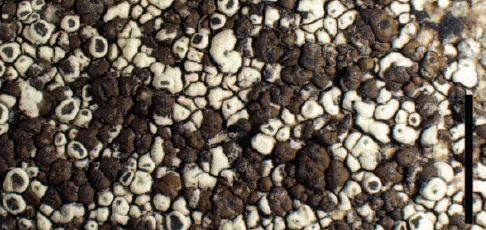Dimelaena lichenicola K. Knudsen, Sheard, Kocourk. & H. Mayrhofer
Bryologist, 116: 259, 2013.
Synonyms:
Distribution: N - TAA (Knudsen & al. 2013).
Description: Thallus crustose, episubstratic, areolate, parasitic on the thalli of other Dimelaena-species, the areoles brown, often solitary or forming small, to 1-2 cm wide patches on the host, at first flat, later convex, up to c. 1.2 mm wide, smooth and glossy at first, becoming rugulose and matt, sometimes with minute, up to c. 0.15 mm wide marginal lobes. Cortex 20-40 μm thick, subparaplectenchymatous, overlain with a thin epinecral layer, with a thin brown upper layer and a thick hyaline lower layer; medulla white, with abundant crystals. Apothecia lecanorine, 1 per areole, 0.1-0.3 mm across, with a black, epruinose disc and a thin thalline margin. Proper exciple prosoplectenchymatous, expanding up to 60 μm at surface of disc, forming a parathecial ring; epithecium red-brown; hymenium colourless, c. 80 μm high; paraphyses coherent, 2-3 μm wide at mid-level, capitate, the apical cells to c. 4.5 μm wide; hypothecium dark red-brown. Asci 8-spored, cylindrical-clavate, the apical dome K/I+ dark blue with a pale, conical-pointed apical cushion (axial mass), the wall I-, but the thin outer gel I+ blue, Bacidia-type. Ascospores 1-septate, brown, the largest ones to 12 x 9.5 μm, thin-walled throughout, with a dark torus, the walls not ornamented, Buellia-type. Pycnidia frequent, immersed, pyriform, with a conspicuous black ostiole. Conidia bacilliform, hyaline, simple, 6-10 μm long (rarely more). Photobiont chlorococcoid. Spot tests: thallus K-, C-, KC-, P-, UV-; medulla K+ yellow turning deep red, with crystals. Chemistry: medulla with norstictic acid (major), and stictic acid (minor).Note: a lichenicolous lichen growing on D. oreina, described from California; the Italian record is the only one from Europe.
Growth form: Crustose
Substrata: rocks
Photobiont: green algae other than Trentepohlia
Reproductive strategy: mainly sexual
Subcontinental: restricted to areas with a dry-subcontinental climate (e.g. dry Alpine valleys, parts of Mediterranean Italy)
paras of Dimelaena oreina
Commonnes-rarity: (info)
Alpine belt: absent
Subalpine belt: absent
Oromediterranean belt: absent
Montane belt: extremely rare
Submediterranean belt: extremely rare
Padanian area: absent
Humid submediterranean belt: absent
Humid mediterranean belt: absent
Dry mediterranean belt: absent

Predictive model

Source: Knudsen & al. The Bryologist, 116(3):257-262, 2013.
Dimelaena lichenicola (Knudsen 15179, holotype). A. Vertical section of apothecium with brown hypothecium. B. Primordium of apothecium.
C. Capitate paraphyses. D. Ascus with semi-mature ascospores. E–F. Young and mature ascospores, sometimes halonate. Bars A, B 5 100 mm. C, E, F 5 10 mm. D 5 20 mm.
Growth form: Crustose
Substrata: rocks
Photobiont: green algae other than Trentepohlia
Reproductive strategy: mainly sexual
Subcontinental: restricted to areas with a dry-subcontinental climate (e.g. dry Alpine valleys, parts of Mediterranean Italy)
paras of Dimelaena oreina
Commonnes-rarity: (info)
Alpine belt: absent
Subalpine belt: absent
Oromediterranean belt: absent
Montane belt: extremely rare
Submediterranean belt: extremely rare
Padanian area: absent
Humid submediterranean belt: absent
Humid mediterranean belt: absent
Dry mediterranean belt: absent

Predictive model

 Index Fungorum
Index Fungorum
 GBIF
GBIF



